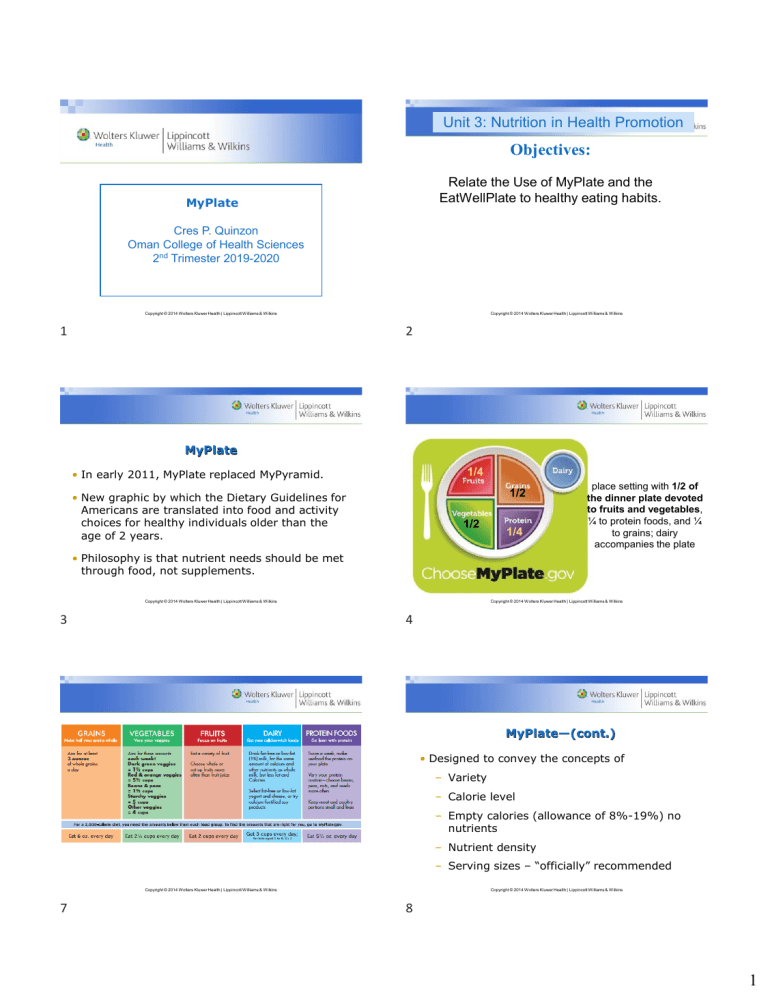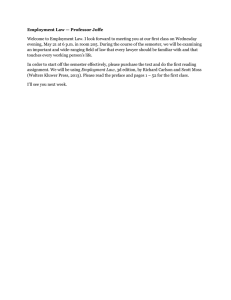
Unit 3: Nutrition in Health Promotion Objectives: Relate the Use of MyPlate and the EatWellPlate to healthy eating habits. MyPlate Cres P. Quinzon Oman College of Health Sciences 2nd Trimester 2019-2020 Copyright © 2014 Wolters Kluwer Health | Lippincott Williams & Wilkins 1 Copyright © 2014 Wolters Kluwer Health | Lippincott Williams & Wilkins 2 MyPlate 1/4 • In early 2011, MyPlate replaced MyPyramid. 1/2 • New graphic by which the Dietary Guidelines for Americans are translated into food and activity choices for healthy individuals older than the age of 2 years. 1/2 1/4 place setting with 1/2 of the dinner plate devoted to fruits and vegetables, ¼ to protein foods, and ¼ to grains; dairy accompanies the plate • Philosophy is that nutrient needs should be met through food, not supplements. Copyright © 2014 Wolters Kluwer Health | Lippincott Williams & Wilkins 3 Copyright © 2014 Wolters Kluwer Health | Lippincott Williams & Wilkins 4 MyPlate—(cont.) • Designed to convey the concepts of – Variety – Calorie level – Empty calories (allowance of 8%-19%) no nutrients – Nutrient density – Serving sizes – “officially” recommended Copyright © 2014 Wolters Kluwer Health | Lippincott Williams & Wilkins 7 Copyright © 2014 Wolters Kluwer Health | Lippincott Williams & Wilkins 8 1 • 1. Grains 1oz eq=1/2 cup cooked rice, pasta or cooked cereal=30g 1 oz dry pasta or rice; 1 slice bread; 1 small muffin; 1 serving ready to eat cereal MyPlate—(cont.) • Basic messages – Eat more fruit, vegetables, and whole grains. • – Eat less saturated fat, trans fat, and cholesterol. • 3. Meats and alternatives= 30g lean meat, poultry or fish; 1 egg: 15g oz nuts or seeds. – Limit sweets and salt. • 4. Legumes: Half cup cooked lentils, beans or peas (¼ cup cooked dry beans or tofu) – Balance calorie intake with calorie expenditure. • 5. Milk and dairy: 1 cup equivalent=1 cup milk or yogurt, 45g natural cheese such as cheddar or 60g oz of processed cheese. – Be physically active most days of the week. Copyright © 2014 Wolters Kluwer Health | Lippincott Williams & Wilkins 9 2. Fruits and vegetables : 1 cup = 1 cup raw or cooked fruit or vegetable, 1/2 cup fruit or vegetable juice, 2 cups leafy salad greens. Copyright © 2014 Wolters Kluwer Health | Lippincott Williams & Wilkins 10 • So, try to eat: • • plenty of fruit and vegetables • • plenty of bread, rice, potatoes, pasta, and other • starchy foods—choose whole grain varieties whenever you can • • some milk and dairy foods • • some meat, fish, eggs, beans, and other nondairy sources of protein • • just a small amount of foods and drinks high in fat and/or sugar Copyright © 2014 Wolters Kluwer Health | Lippincott Williams & Wilkins 11 Copyright © 2014 Wolters Kluwer Health | Lippincott Williams & Wilkins 12 • 8 TIPS FOR EATING WELL • 1. Base your meals on starchy foods • 2. Eat lots of fruit and vegetables • 3. Eat more fish • 4. Cut down on saturated fat and sugar • 5. Try to eat less salt—no more than 6 g/day • 6. Get active and try to be a healthy weight • 7. Drink plenty of water • 8. Don't skip breakfast Copyright © 2014 Wolters Kluwer Health | Lippincott Williams & Wilkins 13 2











